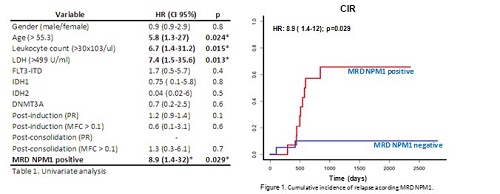
Contributions
Abstract: PB1653
Type: Publication Only
Background
Minimal residual disease (MRD) tests provide early identification of hematologic relapse and timely management of AML patients. About 60% of adult normal karyotype AML has a mutation in exon 12 of NPM1 gene. This mutation is specific for malignant clone and potentially is a good marker of MRD.
Aims
The aim of the study was to analyze the usefulness of NPM1 as a marker for MRD quantification in AML during follow-up.
Methods
Retrospective study included 34 patients with mutated-NPM1 and treated with intensive chemotherapy (2009-2015). Bone marrow (188) and peripheral blood (277) samples were analyzed from complete remission (MRD NPM1 negative). NPM1 detection was performed by quantitative RT-PCR (Gorello et al, Leukemia 2006). Patients were considered positive when presented >1 NPM1 sample positive or/and one sample NPM1 >0.02%. Cox regression was used for univariate analysis.
Results
Patients were segregated in 2 groups: Relapse patients (Group 1: 32.2%, 11/ 34) and no relapse patients (Group 2: 67.6%, 23/34). Group 1 presented MRD NPM1 positive in 9/11 (82%) of patients, the time from NPM1 to relapse was 4.6 months (1.6-24), NPM1 mean was 1.7 (0.03-9). Group 2 presented MRD NPM1 negative (<0.02% y/ or 1 determination) in 21/23 (91%) patients. Univariate analysis was performed and our results show that age, leukocyte, LDH and MRD NPM1 are prognostic factors for cumulative incidence of relapse (Table 1, Figure 1).

Conclusion
NPM1 is a useful marker for MRD quantification in AML patients undergoing intensive therapy. NPM1 positive during follow-up is associated with a higher probability of relapse.
Session topic: 3. Acute myeloid leukemia - Biology
Keyword(s): Minimal residual disease (MRD), Acute Myeloid Leukemia
Abstract: PB1653
Type: Publication Only
Background
Minimal residual disease (MRD) tests provide early identification of hematologic relapse and timely management of AML patients. About 60% of adult normal karyotype AML has a mutation in exon 12 of NPM1 gene. This mutation is specific for malignant clone and potentially is a good marker of MRD.
Aims
The aim of the study was to analyze the usefulness of NPM1 as a marker for MRD quantification in AML during follow-up.
Methods
Retrospective study included 34 patients with mutated-NPM1 and treated with intensive chemotherapy (2009-2015). Bone marrow (188) and peripheral blood (277) samples were analyzed from complete remission (MRD NPM1 negative). NPM1 detection was performed by quantitative RT-PCR (Gorello et al, Leukemia 2006). Patients were considered positive when presented >1 NPM1 sample positive or/and one sample NPM1 >0.02%. Cox regression was used for univariate analysis.
Results
Patients were segregated in 2 groups: Relapse patients (Group 1: 32.2%, 11/ 34) and no relapse patients (Group 2: 67.6%, 23/34). Group 1 presented MRD NPM1 positive in 9/11 (82%) of patients, the time from NPM1 to relapse was 4.6 months (1.6-24), NPM1 mean was 1.7 (0.03-9). Group 2 presented MRD NPM1 negative (<0.02% y/ or 1 determination) in 21/23 (91%) patients. Univariate analysis was performed and our results show that age, leukocyte, LDH and MRD NPM1 are prognostic factors for cumulative incidence of relapse (Table 1, Figure 1).

Conclusion
NPM1 is a useful marker for MRD quantification in AML patients undergoing intensive therapy. NPM1 positive during follow-up is associated with a higher probability of relapse.
Session topic: 3. Acute myeloid leukemia - Biology
Keyword(s): Minimal residual disease (MRD), Acute Myeloid Leukemia


